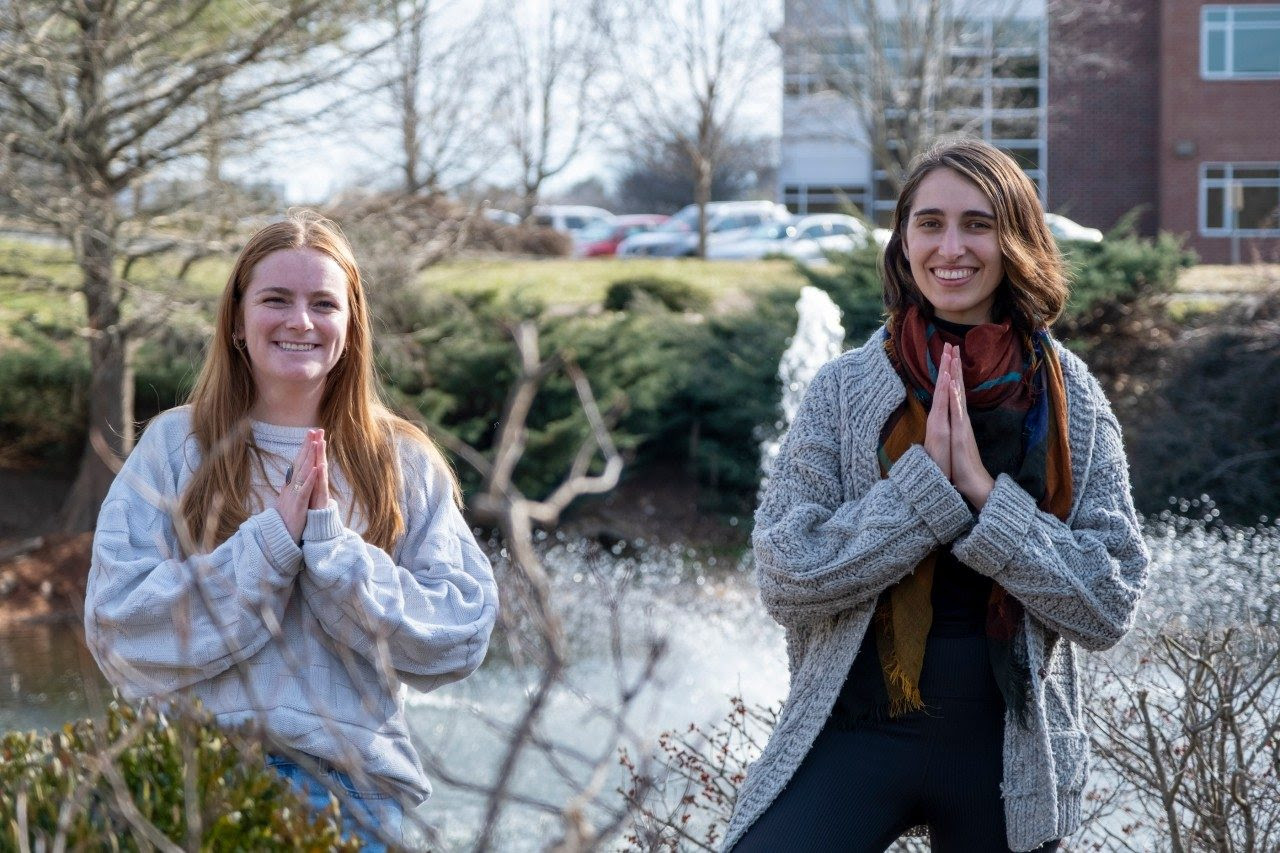
Therese Osborn and Mary Frazier do a yoga pose in front of a fountain in the Virginia Tech Corporate Research Center.
From the downward dog to the reverse warrior, yoga’s popularity has blossomed recently, partly because of its accessibility to a wide range of people at a variety of skill levels.
With benefits ranging from physical to mental to social and spiritual, yoga offers an approach to holistic well-being. Virginia Tech researchers are working on ways to broaden its appeal even further.
“The historical underrepresentation in yoga makes this the perfect thing to study in regard to equitable translation of health evidence,” said Mary Frazier, who is pursuing her Ph.D. in the Translational Biology, Medicine, and Health Graduate Program and is the graduate student lead on the project. “So many people think yoga isn’t for them and that’s largely because of how it’s often portrayed. We want to find ways to reach the groups that don’t think yoga is for them – because it could be.”
The underrepresentation of people from rural areas in yoga practices highlights significant accessibility and awareness issues, often due to a lack of local resources and classes that could introduce and nurture an inclusive yoga culture, the researchers said.
Additionally, according to the research team, prevailing narratives around body image within the yoga community can deter many from participating, as the physical component of yoga is easier to capture ‘on screen’ (e.g., photo or video), but the imagery often lacks representation of the diversity of human bodies.
“These challenges underscore the need for a more inclusive approach to yoga, one that embraces and promotes diversity in all forms, from geographical background to body shape, ensuring that the benefits of yoga are accessible to all,” said Samantha Harden, an associate professor in the Department of Human Nutrition, Foods, and Exercise and a Virginia Cooperative Extension specialist.
To help bridge this gap, the research team made up of Harden; Frazier; Brad Frick, a master’s degree student in the School of Communication; and Therese Osborn, an undergraduate student in public health, as well as Rachel Kaplan, Cassidy Powers, and Kayla Markley, all students in human nutrition, foods, and exercise, created a messaging survey to identify terms and tactics that resonate with the historically underrepresented groups.
The development of a survey aimed at identifying effective tactics and messaging to engage historically underrepresented groups in yoga represents a strategic approach to fostering inclusivity within the practice. Through a collaboration with University Libraries, this research project can leverage advanced data visualization tools and expertise, transforming raw survey data into compelling, easy-to-understand insights that highlight opportunities for outreach and community engagement.
“This partnership not only amplifies the survey’s impact through sophisticated analysis but also ensures that the findings are accessible and actionable for stakeholders aiming to create a more inclusive yoga community,” said Harden, who is also affiliated with the Fralin Biomedical Institute.
“It’s going to be interesting to see and transform the raw survey data into insightful and meaningful visualizations,” said Michael Stamper, a University Libraries data visualization designer. “Once we can see the stories within that data, we can begin to take notice of and address them.”
The research project also gave Frazier valuable experience as a graduate student.
“This project has been instrumental in advancing my Ph.D. journey, providing a solid foundation for my dissertation on the importance of inclusivity in wellness spaces and highlighting the transformative potential of yoga when it truly embraces diversity in all its forms,” Frazier said. “The research into the underrepresentation of individuals from rural areas in yoga practices has illuminated critical gaps in accessibility and awareness, underscoring the urgent need for community-based interventions and inclusive programming.”
Osborn, a sophomore, was “nervous” when she first joined the lab — it’s the same nervousness that keeps people out of studios: the unknown. She now acknowledges that the experience has equipped her with valuable skills, preparing her for the workforce.
“Dr. Harden, Frazier, Megan Pullin, and the rest of the lab have been so welcoming and encouraging,” Osborn said. “Not only has the lab allowed me to apply what I have learned in my classes, but it has also taught me new things entirely, that help me to feel prepared for the future. This project has taught me how to build a successful survey and analyze qualitative data.”
Tom Soladay for Virginia Tech




